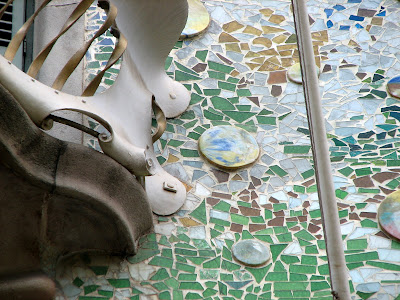 Friday, 1pm: the next train to a small village called Ronchamp was leaving in an hour from the Paris Gare du Nord. I had thirty minutes to pack for that trip, and possibly others.
Friday, 1pm: the next train to a small village called Ronchamp was leaving in an hour from the Paris Gare du Nord. I had thirty minutes to pack for that trip, and possibly others.Visiting Le Corbusier’s
chapel of Notre Dame du Haut would suffice as justification for a day of unexcused absence from work. I had run into a group of Princeton students on my way back from a shisha place the night before, and together we had set off for an establishment known as Social Club. As a consequence I was unable to get up in time for work on Friday. The other kilo interns had departed for Amsterdam for the weekend and would not be going to work either. So I—in the spirit of a true
KGS alum—decided to take the day off.

I had looked for an itinerary that didn’t require a reservation, so I just stepped into the train and by 6:30pm I was in a small town called Lure, waiting for the shuttle that would take me to Ronchamp.

Finally I landed in a small village in the middle of nowhere: what was Le Corbusier—forger of rules for a new machine architecture, and conceiver of utopian urban schemes such as the
Plan Voisin—doing here. While the man calls for regulation and standardization, his architecture transcends that. It is sculptural, harmonious, thoughtful, and serene. It denies mass-production and repetition. It embraces the individuality of the artist, and acknowledges human inhabitation. That is what draws me to Le Corbusier: his unrelenting conceptual idealism and his built works complement each other. To study one in isolation is misleading. The
five points are not enough; they need masters such as Gaudi and Horta and Corbusier and Mies to articulate them. This idea undermines some precepts of modernism—such as the belief in a supposed International Style—but it redeems modern architecture.

The chapel was outside the village itself. I walked uphill for 20 minutes on a completely deserted pathway. The setting sun was brilliant and formed bright yellow outlines on the grassy horizon. Bees were buzzing, and it smelled like spring. It reminded me of the journey of the hobbits in the Lord of the Rings.

I reached the top to find that the gates had been shut at 7:30pm. That explained why I was the only person for as far as I could see. On the bright side, I had the chapel all to myself. I walked around the boundary wall, catching glimpses of it. It was symbolic of my quest to become an architect: alluring but elusive.
I saw hills of fresh mud, which was the landscaping for the new addition that will soon be constructed there. It is a Renzo Piano project and has been the subject of much controversy. I entered the construction site, deserted as it was, and climbed a large hill to get a better view of that fleeting wonder.

The sun was setting now and I began to wonder where I would spend the night. A car came along from the other side of the hill and a man began to lock the gate to the construction area. This would have locked me in so I called out to him. He was kind enough to wait for me and let me out. I asked him if he was going downhill and if I could go with him. He turned out to be a surveyor for Piano’s project. On our way down, Denis—that was his name, if I remember correctly—explained how complicated the project is: the Fondation Le Corbusier wants the chapel to retain its quality of being visible at the top of the hill from all sides, so Piano’s project will be as hidden as possible. There are constant deliberations about things such as old trees that must be preserved, forcing the new design to accommodate them. When you’re talking about names such as Corbusier and Piano, he said, everything is a very big deal.

It turned out he was going to Belfort, the closest real city to Ronchamp. I would either need to find a train back to Paris or look for a place to spend the night in the vicinity, and in either case Belfort would be a good place to head to. And so he dropped me off at the Belfort train station.
 I was at the top of the world. I stood on a thin metal parapet, the landing of a narrow staircase supported on the roof of the building. I clutched the delicate iron framework and could feel the ripple of the heavy concrete mass underneath, and the earth from which it rose. The vast horizon, with mountains on one side and the sea on the other, made me dizzy, and the warm sea breeze made me unsteady, so I held the metal more tightly.
I was at the top of the world. I stood on a thin metal parapet, the landing of a narrow staircase supported on the roof of the building. I clutched the delicate iron framework and could feel the ripple of the heavy concrete mass underneath, and the earth from which it rose. The vast horizon, with mountains on one side and the sea on the other, made me dizzy, and the warm sea breeze made me unsteady, so I held the metal more tightly.



















































